-
-
 Energy and Climate Databases
Energy and Climate Databases- The most comprehensive and up-to-date annual energy database.
- Monitoring of technology providers in H2 supply chain.
- Monthly energy data on key energy markets.
- The most reliable and up-to-date power generation database.
- The essentials of LNG trade at your fingertips.
- Global monitoring of new and existing refineries.
- Analyse energy consumption and efficiency trends at world level. Benchmark countries.
- Have your database developed by a recognised expert of both energy and IT.
-
 Energy - Climate Forecasts
Energy - Climate Forecasts- Instant access to energy and emissions forecasts.
- Strategic, annual wholesale price projections backed by Enerdata's energy modelling expertise and our globally recognised POLES model.
- Wedges module showing a breakdown of the levers enabling to reduce emissions between two scenarios.
- Unique, independent projections of consumption by end-use.
- GHG Marginal Abatement Cost Curves.
- Benefit from proven models to draw your own energy scenarios and anticipate tomorrow’s challenges.
-
 Market Intelligence
Market Intelligence- 110 Energy and climate country reports
- A newsletter to receive the latest updates on evolving technologies and policies.
- Global energy news and analyses curated daily.
- Enerdata’s experts bring you the essentials about your market and competitors.
-
-
-
 Market Analysis
Market Analysis- Understanding key consumption trends and drivers across sectors.
- Granular and exclusive insight to address the most pressing business and strategic issues.
- Expertise in strategic and business intelligence, with fine-tuning to the market’s specificities.
-
 Energy - Climate Scenarios
Energy - Climate Scenarios- Providing the outlook of an energy commodity in mid to long term time horizons.
- Sector and driver specific energy demand forecasting.
- Assess the evolution of energy prices on the international and regional markets, as well as end-users prices.
- Enerdata guides you through pathways to reach climate targets.
- Supporting local authorities in their decarbonisation strategies.
-
 Climate Strategy and Policy Evaluation
Climate Strategy and Policy Evaluation- Cutting-edge quantitative tools and relevant indicators to monitor and evaluate evolutions on worldwide energy markets.
- Analysis of the most cost-effective options to reduce emissions.
- Quantified simulation and analysis of pledges for climate change negotiations.
- Breakdown of carbon markets and evaluation of the climate change impacts on the carbon price.
- Enerdata guides you on the most beneficial policy or investment options.
- Turning climate objectives into concrete action plans.
-
 Training
Training- Understand different policy targets and measures on energy efficiency.
- How to measure energy savings?
- Energy Forecasting is a 2 days training to learn to design and interpret energy forecasts.
- Energy statistics training allowing to create energy balance with supply, transformation and consumption and understanding the international energy statistics regulations.
- Initiation to EnerMED level 1is the training to approach on the most powerful energy demand forecasting model.
-
-
Resource Centre
Morocco Key Figures
- Population:
- 37.5 million
- GDP growth rate:
- 1.08 %/year
- Energy independence:
- 9.73%
Data of the last year available: 2022
- Total consumption/GDP:*
- 87.7 (2005=100)
- CO2 Emissions:
- 1.79 tCO2/capita
- Rate of T&D power losses:
- 17.1%
* at purchasing power parity
View all macro and energy indicators in the Morocco energy report
Morocco Energy News
View all news, archive your new and create your own daily newsletters only on your topics/countries of interest with Key Energy Intelligence
Morocco Energy Research
Benefit from up to 2 000 up-to-date data series for 186 countries in Global Energy & CO2 data
A data overview is available in the global energy statistics app
Morocco Total Energy Consumption
In 2022, per capita energy consumption was 0.60 toe (compared to 0.88 toe in Egypt, 1.49 toe in Algeria, and 0.94 toe in Tunisia), including around 965 kWh of electricity (34% below the North Africa average).
Graph: CONSUMPTION TRENDS BY ENERGY SOURCE (Mtoe)
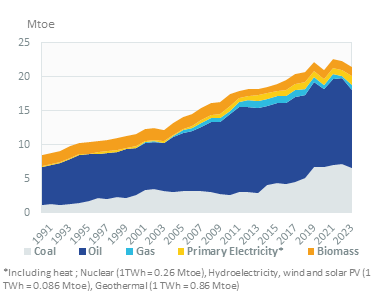
Total energy consumption decreased by 1.4% in 2022 to 22.5 Mtoe, after an 8% increase in 2021. Over 2010-2019, it grew by 3%/year on average, which is much slower than over 2000-2010 (5%/year).
Interactive Chart Morocco Total Energy Consumption
Benefit from up to 2 000 up-to-date data series for 186 countries in Global Energy & CO2 data
View the detailed fondamentals of the market at country level (graphs, tables, analysis) in the Morocco energy report
Morocco Crude Oil Production
The production of oil is very low. All the oil products are imported since the shutdown of the sole refinery of the country in 2015 (200 kb/d). Oil product imports have increased by 30% since 2015 (+5.8% in 2022 alone) to 13.5 Mt.
Interactive Chart Morocco Crude Oil Production
Benefit from up to 2 000 up-to-date data series for 186 countries in Global Energy & CO2 data
Additionally, for more detailed information on refineries, you can request a sample of our EMEA Refineries Dataset
Morocco Oil Products Consumption
Oil product consumption hovers over 12 Mt since 2010. It contracted by 9% in 2020 but recovered in 2021 (+11%) and remained stable at 12.6 Mt in 2022. Previously, it had increased by around 5%/year between 2004 and 2010.
The transport sector consumes 43% of oil products, followed by the residential-services sector (29%), industry (15%), and power plants (9%).
Graph: OIL CONSUMPTION (Mt)
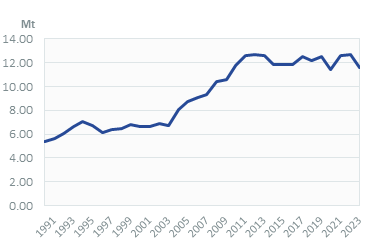
Graph: OIL CONSUMPTION BREAKDOWN BY SECTOR (2022, %)
Interactive Chart Morocco Refined Oil Products Production
Benefit from up to 2 000 up-to-date data series for 186 countries in Global Energy & CO2 data
Additionally, for more detailed information on refineries, you can request a sample of our EMEA Refineries Dataset
Morocco Natural Gas Consumption
Natural gas consumption has been divided by 5 since 2017 (-71% to 240 mcm in 2022 alone), due to the increased use of coal and renewables in the power sector. It had surged between 2005 and 2012, after the commissioning of the Tahaddart and Tarfaya plants.
The power sector accounted for 67% of gas consumption in the country in 2022, the rest being consumed by industry (32%).
Graph: NATURAL GAS CONSUMPTION (bcm)
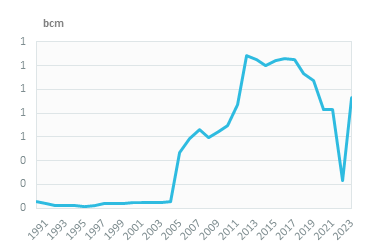
Interactive Chart Morocco Natural Gas Domestic Consumption
Benefit from up to 2 000 up-to-date data series for 186 countries in Global Energy & CO2 data
Additionally, for more detailed information on the LNG trade, you can request a sample of our EMEA LNG Trade Dataset
Morocco Coal Consumption
Coal consumption rose by 1.3% in 2022 to 10.8 Mt, after a 4.9% increase in 2021. Coal consumption surged (+11%/year) between 2014 and 2019 with the commissioning of new coal power plants.
Coal is entirely used for power generation.
Graph: COAL CONSUMPTION (Mt)
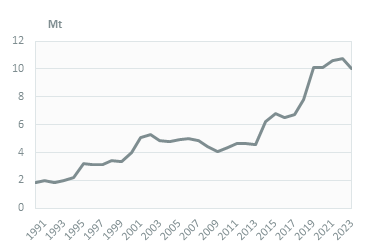
Graph: COAL CONSUMPTION BREAKDOWN BY SECTOR (2022, %)
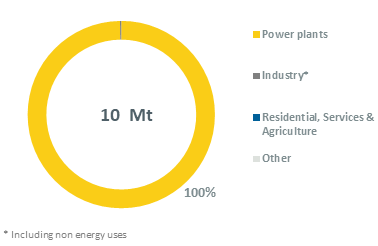
Interactive Chart Morocco Coal and Lignite Domestic Consumption
Benefit from up to 2 000 up-to-date data series for 186 countries in Global Energy & CO2 data
View the detailed consumption trends at country level (graphs, tables, analysis) in the Morocco energy report
Morocco Power Consumption
Electricity consumption is increasing rapidly, doubling since 2005 with the implementation of the electrification programme to 36 TWh in 2022 (+4.8%/year since 2020). According to preliminary estimates, electricity consumption rose by 2.7% in 2023, thanks to higher sales to large consumers and distributors.
Industry is the largest electricity consumer (38% in 2022), followed by households (34%) and services (17%).
Graph: ELECTRICITY CONSUMPTION (TWh)
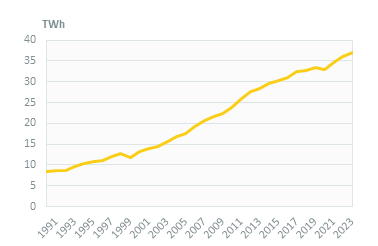
Morocco Renewable in % Electricity Production
MASEN, the Moroccan Agency for Sustainable Energy, was established in 2010 to manage developments of solar power. Its responsibilities were extended in 2016 to coordinate all renewable projects, including wind and hydro. ONEE and AMEE will gradually transfer to Masen all projects and assets related to renewables (initially planned over a transitional period of 5 years but still underway at the end of 2023, although the majority of projects have been transferred to Masen).
Interactive Chart Morocco Share of Renewables in Electricity Production (incl hydro)
Benefit from up to 2 000 up-to-date data series for 186 countries in Global Energy & CO2 data
Morocco CO2 Fuel Combustion/CO2 Emissions
In its updated NDC (2021), Morocco set an unconditional target of an 18.3% reduction in GHG emissions by 2030 (compared to a BAU projection), compared to a 17% reduction in the previous NDC. This corresponds to emissions of 116 Mt CO2eq in 2030. The country will have to invest US$18bn to reach this goal. Morocco could commit to another 27% (45.5% target) on condition of international financial support of around US$21.5bn. The NDC's action plan consists of 61 options, 34 of which are unconditional.